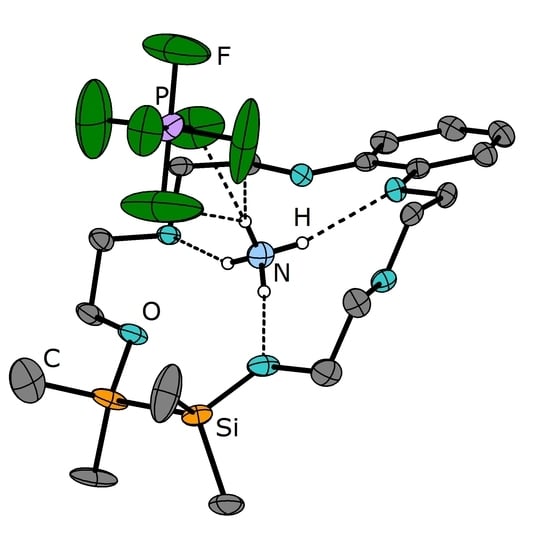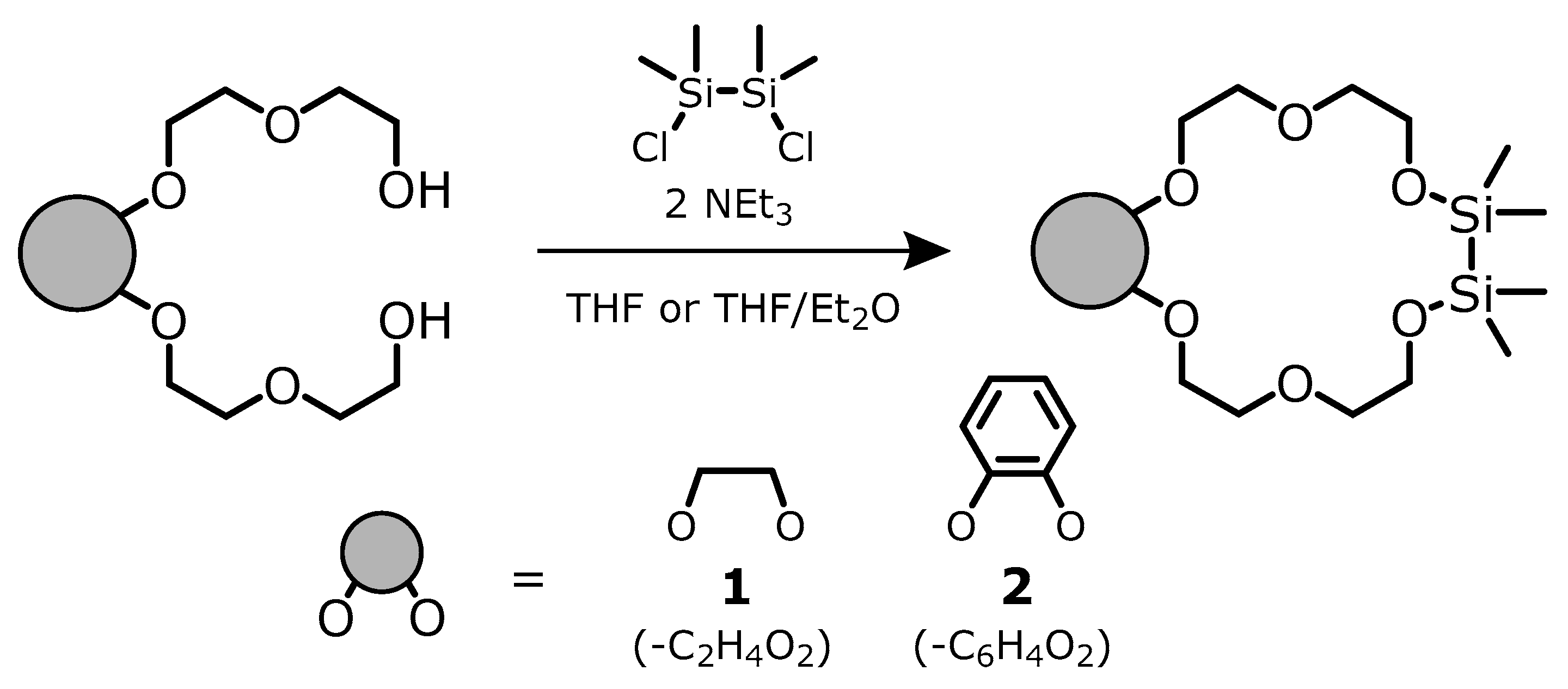Hybrid Disila-Crown Ethers as Hosts for Ammonium Cations: The O–Si–Si–O Linkage as an Acceptor for Hydrogen Bonding
Abstract
:1. Introduction
2. Results
3. Materials and Methods
3.1. Laboratory Procedures and Techniques
3.2. Crystal Structures
3.3. Experimental Section
4. Conclusions
Supplementary Materials
Acknowledgments
Author Contributions
Conflicts of Interest
References
- Weinhold, F.; West, R. The nature of the silicon–oxygen bond. Organometallics 2011, 30, 5815–5824. [Google Scholar] [CrossRef]
- Weinhold, F.; West, R. Hyperconjugative Interactions in Permethylated Siloxanes and Ethers: The Nature of the SiO Bond. J. Am. Chem. Soc. 2013, 135, 5762–5767. [Google Scholar] [CrossRef] [PubMed]
- Ritch, J.S.; Chivers, T. Siliciumanaloga von Kronenethern und Cryptanden: Ein neues Kapitel in der Wirt-Gast-Chemie? Angew. Chem. 2007, 119, 4694–4697. [Google Scholar] [CrossRef]
- Shambayati, S.; Blake, J.F.; Wierschke, S.G.; Jorgensen, W.L.; Schreiber, S.L. Structure and Basicity of Silyl Ethers: A Crystallographic and ab Initio Inquiry into the Nature of Silicon–Oxygen Interactions. J. Am. Chem. Soc. 1990, 112, 697–703. [Google Scholar] [CrossRef]
- Cypryk, M.; Apeloig, Y. Ab Initio Study of Silyloxonium Ions. Organometallics 1997, 16, 5938–5949. [Google Scholar] [CrossRef]
- Gillespie, R.J.; Robinson, E. Models of molecular geometry. Chem. Soc. Rev. 2005, 34, 396–407. [Google Scholar] [CrossRef] [PubMed]
- Passmore, J.; Rautiainen, J.M. On The Lower Lewis Basicity of Siloxanes Compared to Ethers. Eur. J. Inorg. Chem. 2012, 2012, 6002–6010. [Google Scholar] [CrossRef]
- Cameron, T.S.; Decken, A.; Krossing, I.; Passmore, J.; Rautiainen, J.M.; Wang, X.; Zeng, X. Reactions of a Cyclodimethylsiloxane (Me2SiO)6 with Silver Salts of Weakly Coordinating Anions; Crystal Structures of [Ag(Me2SiO)6][Al] ([Al] = [FAl{OC(CF3)3}3], [Al{OC(CF3)3}4]) and Their Comparison with [Ag(18-Crown-6)]2[SbF6]2. Inorg. Chem. 2013, 52, 3113–3126. [Google Scholar] [CrossRef] [PubMed]
- Ouchi, M.; Inoue, Y.; Kanzaki, T.; Hakushi, T. Ring-contracted Crown Ethers: 14-Crown-5, 17-Crown-6, and Their Sila-analogues. Drastic Decrease in Cation-binding Ability. Bull. Chem. Soc. Jpn. 1984, 57, 887–888. [Google Scholar] [CrossRef]
- Inoue, Y.; Ouchi, M.; Hakushi, T. Molecular Design of Crown Ethers. 3. Extraction of Alkaline Earth and Heavy Metal Picrates with 14- to 17-Crown-5 and 17- to 22-Crown-6. Bull. Chem. Soc. Jpn. 1985, 58, 525–530. [Google Scholar] [CrossRef]
- Reuter, K.; Buchner, M.R.; Thiele, G.; von Hänisch, C. Stable Alkali-Metal Complexes of Hybrid Disila-Crown Ethers. Inorg. Chem. 2016, 55, 4441–4447. [Google Scholar] [CrossRef] [PubMed]
- Reuter, K.; Thiele, G.; Hafner, T.; Uhlig, F.; von Hänisch, C. Synthesis and coordination ability of a partially silicon based crown ether. Chem. Commun. 2016, 52, 13265–13268. [Google Scholar] [CrossRef] [PubMed]
- Reuter, K.; Rudel, S.S.; Buchner, M.R.; Kraus, F.; von Hänisch, C. Crown ether complexes of alkali metal chlorides from SO2. Chem. Eur. J. 2017, 23, 9607–9617. [Google Scholar] [CrossRef] [PubMed]
- Reuter, K.; Dankert, F.; Donsbach, C.; von Hänisch, C. Structural Study of Mismatched Disila-Crown Ether Complexes. Inorganics 2017, 5, 11. [Google Scholar] [CrossRef]
- Dankert, F.; Reuter, K.; Donsbach, C.; von Hänisch, C. A structural study of alkaline earth metal complexes with hybrid disila-crown ethers. Dalton Trans. 2017, 46, 8727–8735. [Google Scholar] [CrossRef] [PubMed]
- West, R.; Whatley, L.S.; Lake, K.J. Hydrogen Bonding Studies. V. The Relative Basicities of Ethers, Alkoxysilanes and Siloxanes and the Nature of the Silicon–Oxygen Bond. J. Am. Chem. Soc. 1961, 83, 761–764. [Google Scholar] [CrossRef]
- West, R.; Wilson, L.S.; Powell, D.L. Basicity of siloxanes, alkoxysilanes and ethers toward hydrogen bonding. J. Organomet. Chem. 1979, 178, 5–9. [Google Scholar] [CrossRef]
- Popowski, E.; Schulz, J.; Feist, K.; Kelling, H.; Jancke, H. Basizität und 29Si-NMR-spektroskopische Untersuchungen von Ethoxysiloxanen. Z. Anorg. Allg. Chem. 1988, 558, 206–216. [Google Scholar] [CrossRef]
- Yilgör, E.; Burgaz, E.; Yurtsever, E.; Yilgör, I. Comparison of hydrogen bonding in polydimethylsiloxane and polyether based urethane and urea copolymers. Polymer 2000, 41, 849–857. [Google Scholar] [CrossRef]
- Jeffrey, G.A. An Introduction to Hydrogen Bonding; Oxford University Press: Oxford, UK, 1997. [Google Scholar]
- Grabowsky, S.; Beckmann, J.; Luger, P. The Nature of Hydrogen Bonding Involving the Siloxane Group. Aust. J. Chem. 2012, 65, 785–795. [Google Scholar] [CrossRef]
- Frolov, Y.L.; Voronkov, M.G.; Strashnikova, N.V.; Shergina, N.I. Hydrogen bonding involving the siloxane group. J. Mol. Struct. 1992, 270, 205–215. [Google Scholar] [CrossRef]
- Grabowsky, S.; Hesse, M.F.; Paulmann, C.; Luger, P.; Beckmann, J. How to Make the Ionic Si–O Bond More Covalent and the Si–O–Si Linkage a Better Acceptor for Hydrogen Bonding. Inorg. Chem. 2009, 48, 4384–4393. [Google Scholar] [CrossRef] [PubMed]
- Behr, J.P.; Dumas, P.; Moras, D. The H3O+ Cation: Molecular Structure of an Oxonium-Macrocyclic Polyether Complex. J. Am. Chem. Soc. 1982, 104, 4540–4543. [Google Scholar] [CrossRef]
- Atwood, J.L.; Bott, S.G.; Means, C.M.; Coleman, A.W.; Zhang, H.; May, M.T. Synthesis of salts of the hydrogen dichloride anion in aromatic solvents. 2. Syntheses and crystal structures of [K∙18-crown-6][Cl–H–Cl], [Mg∙18-crown-6][Cl–H–Cl]2, [H3O∙18-crown-6][Cl–H–Cl], and the Related [H3O∙18-crown-6][Br–H–Br]. Inorg. Chem. 1990, 29, 467–470. [Google Scholar] [CrossRef]
- Atwood, J.L.; Bott, S.G.; Robinson, K.D.; Bishop, E.J.; May, M.T. Preparation and X-ray structure of [H3O+ ·18-crown-6]-[(H5O2+)(Cl−)2], a compound containing both H3O+ and H5O2+ crystallized from aromatic solution. J. Crystallogr. Spectrosc. Res. 1991, 21, 459–462. [Google Scholar] [CrossRef]
- Atwood, J.L.; Junk, P.C.; May, M.T.; Robinson, K.D. Synthesis and X-ray structure of [H3O+ · 18-crown-6] [Br–Br–Br−]; a compound containing both H3O+ and a linear and symmetrical Br3− ion crystallized from aromatic solution. J. Chem. Crystallogr. 1994, 24, 243–245. [Google Scholar] [CrossRef]
- Saleh, M.I.; Kusrini, E.; Fun, H.-K.; Teh, J.B.-J. Dicyclohexano-18-crown-6 hydroxonium tribromide. Acta Cryst. 2007, E63, o3790–o3791. [Google Scholar] [CrossRef]
- Kloo, L.; Svensson, P.H.; Taylor, M.J. Investigations of the polyiodides H3O·Ix (x = 3, 5 or 7) as dibenzo-18-crown-6 complexes. J. Chem. Soc. Dalton Trans. 2000, 1061–1065. [Google Scholar] [CrossRef]
- Cheng, M.; Liu, X.; Luo, Q.; Duan, X.; Pei, C. Cocrystals of ammonium perchlorate with a series of crown ethers: Preparation, structures, and properties. CrystEngComm 2016, 18, 8487–8496. [Google Scholar] [CrossRef]
- Feinberg, H.; Columbus, I.; Cohen, S.; Rabinovitz, M.; Shoham, G.; Selig, H. Crystallographic evidence for different modes of interaction of BF3/BF4− species with water molecules and 18-crown-6. Polyhedron 1993, 12, 2913–2919. [Google Scholar] [CrossRef]
- Dapporto, P.; Paoli, P.; Matijašić, I.; Tuśek-Božić, L. Crystal structures of complexes of ammonium and potassium hexafluorophosphate with dibenzo-18-crown-6. Molecular mechanics studies on the uncomplexed macrocycle. Inorg. Chim. Acta 1996, 252, 383–389. [Google Scholar] [CrossRef]
- Ponomarova, V.V.; Rusanova, J.A.; Rusanov, E.B.; Domasevitch, K.V. Unusual centrosymmetric structure of [M(18-crown-6)]+ (M = Rb, Cs and NH4) complexes stabilized in an environment of hexachloridoantimonate(V) anions. Acta Crystallogr. Sect. C Struct. Chem. 2015, 71, 867–872. [Google Scholar] [CrossRef] [PubMed]
- Hurd, D.T. On the Mechanism of the Acid-catalyzed Rearrangement of Siloxane Linkages in Organopolysiloxanes. J. Am. Chem. Soc. 1955, 77, 2998–3001. [Google Scholar] [CrossRef]
- Cypryk, M.; Apeloig, Y. Mechanism of the Acid-Catalyzed Si–O Bond Cleavage in Siloxanes and Siloxanols. A Theoretical Study. Organometallics 2002, 21, 2165–2175. [Google Scholar] [CrossRef]
- Wu, D.H.; Wu, Q.Q. Ammonium hexafluoridophosphate-18-crown-6 (1/1). Acta Crystallogr. Sect. E Struct. Rep. Online 2010, 66, 2–9. [Google Scholar] [CrossRef] [PubMed]
- Shephard, D.S.; Zhou, W.; Maschmeyer, T.; Matters, J.M.; Roper, C.L.; Parsons, S.; Johnson, B.F.G.; Duer, M.J. Ortsspezifische Derivatisierung von MCM-41: Molekulare Erkennung und Lokalisierung funktioneller Gruppen in mesoporösen Materialien durch hochauflösende Transmissionselektronenmikroskopie. Angew. Chem. 1998, 110, 2847–2851. [Google Scholar] [CrossRef]
- Kociok-Köhn, G.; Molloy, K.C.; Price, G.J.; Smith, D.R.G. Structural characterisation of trimethylsilyl-protected DNA bases. Supramol. Chem. 2008, 20, 697–707. [Google Scholar] [CrossRef]
- Ha, H.-J.; Choi, C.-J.; Ahn, Y.-G.; Yun, H.; Dong, Y.; Lee, W.K. Cycloaddition of Lewis Acid-Induced N-Methyleneanilines as Azadienes to 1,2-Bistrimethylsilyloxycyclobutene and Oxidative Ring Expansion to 1,2,4,5-Tetrahydro-1-benzazocine-3,6-diones. J. Org. Chem. 2000, 65, 8384–8386. [Google Scholar] [CrossRef] [PubMed]
- Becker, B.; Baranowska, K.; Chojnacki, J.; Wojnowski, W. Cubane-like structure of a silanethiol—Primary amine assembly—A novel, unusual hydrogen bond pattern. Chem. Commun. 2004, 620–621. [Google Scholar] [CrossRef] [PubMed]
- Polishchuk, A.P.; Makarova, N.N.; Astapova, T.V. X-ray diffraction investigation of trans-2,8-dihydroxy-2,8-diphenyl-4,4′,6,6′,10,10′, 12,12′-octamethylcyclohexasiloxane and trans-2,8-dihydroxy-2,4,4′,6,6′,8,10,10′, 12,12′-decamethyl-5-carbahexacyclosiloxane. Crystallogr. Rep. 2002, 47, 798–804. [Google Scholar] [CrossRef]
- Spielberger, A.; Gspaltl, P.; Siegl, H.; Hengge, E.; Gruber, K. Syntheses, structures and properties of dihydroxypermethylcyclosilanes and permethyloxahexasilanorbornanes. J. Organomet. Chem. 1995, 499, 241–246. [Google Scholar] [CrossRef]
- Driver, T.G.; Franz, A.K.; Woerpel, K.A. Diastereoselective Silacyclopropanations of Functionalized Chiral Alkenes. J. Am. Chem. Soc. 2002, 124, 6524–6525. [Google Scholar] [CrossRef] [PubMed]
- Myers, A.G.; Dragovich, P.S. A Reaction Cascade Leading to 1,6-didehydro[10]annulene → 1,5-dehydronaphthalene Cyclization Initiated by Thiol Addition. J. Am. Chem. Soc. 1993, 115, 7021–7022. [Google Scholar] [CrossRef]
- Veith, M.; Rammo, A. Synthese und Struktur eines neuartigen molekularen λ5-Organospirosilikats und dessen dynamisches Verhalten in Lösung. J. Organomet. Chem. 1996, 521, 429–433. [Google Scholar] [CrossRef]
- Heyns, A.M.; van Schalkwyk, G.J. A study of the infrared and Raman spectra of ammonium hexafluorophosphate NH4PF6 over a wide range of temperatures. Spectrochim. Acta Part A Mol. Spectrosc. 1973, 29, 1163–1175. [Google Scholar] [CrossRef]
- Willcott, M.R. MestRe Nova. J. Am. Chem. Soc. 2009, 131, 13180. [Google Scholar] [CrossRef]
- OPUS; Version 7.2; Bruker Opt. GmbH: Ettlingen, Germany, 2012.
- Sheldrick, G.M. SHELXT—Integrated space-group and crystal-structure determination. Acta Crystallogr. Sect. A Found. Adv. 2015, 71, 3–8. [Google Scholar] [CrossRef] [PubMed]
- Sheldrick, G.M. Crystal structure refinement with SHELXL. Acta Crystallogr. Sect. C Struct. Chem. 2015, 71, 3–8. [Google Scholar] [CrossRef] [PubMed]
- Dolomanov, O.V.; Bourhis, L.J.; Gildea, R.J.; Howard, J.A.K.; Puschmann, H. OLEX2: A complete structure solution, refinement and analysis program. J. Appl. Crystallogr. 2009, 42, 339–341. [Google Scholar] [CrossRef]
- Diamond; Version 4.4.1; Crystal and Molecular Structure Visualization; Putz, H. & Brandenburg, K. GbR: Bonn, Germany, 2017.
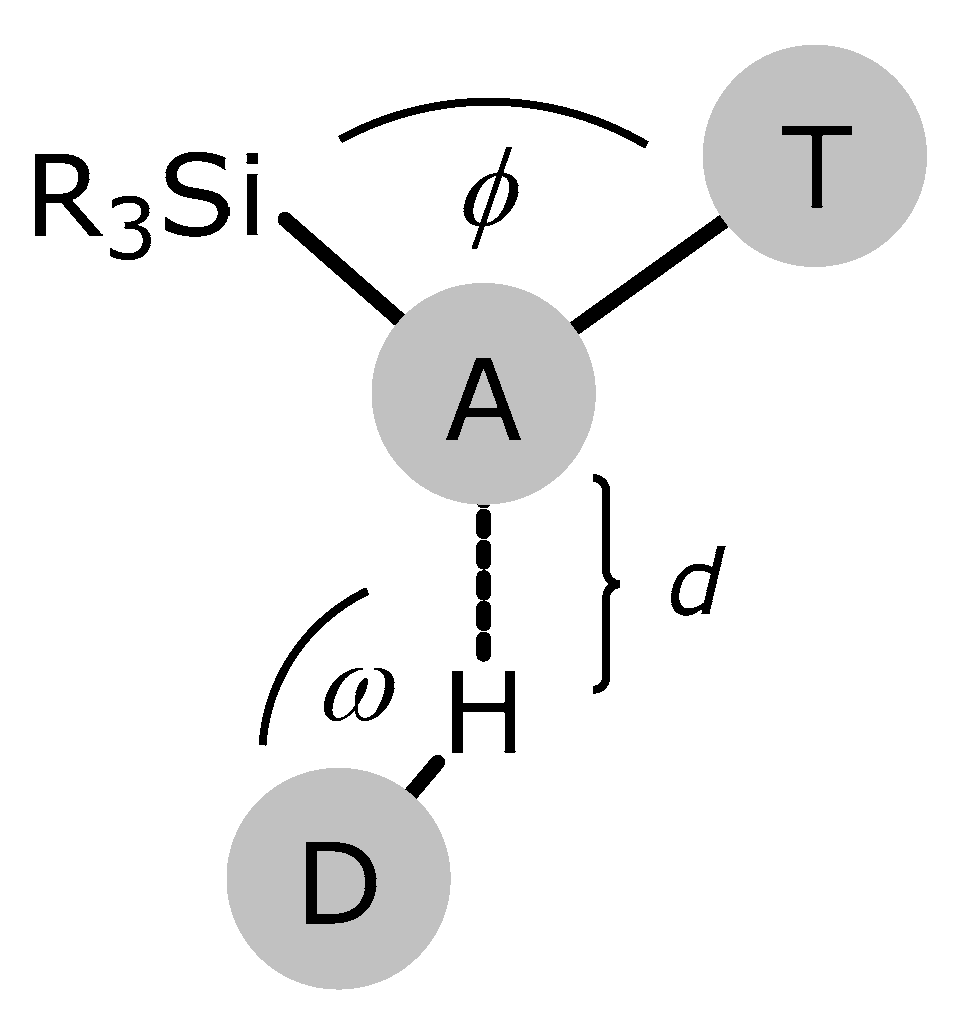
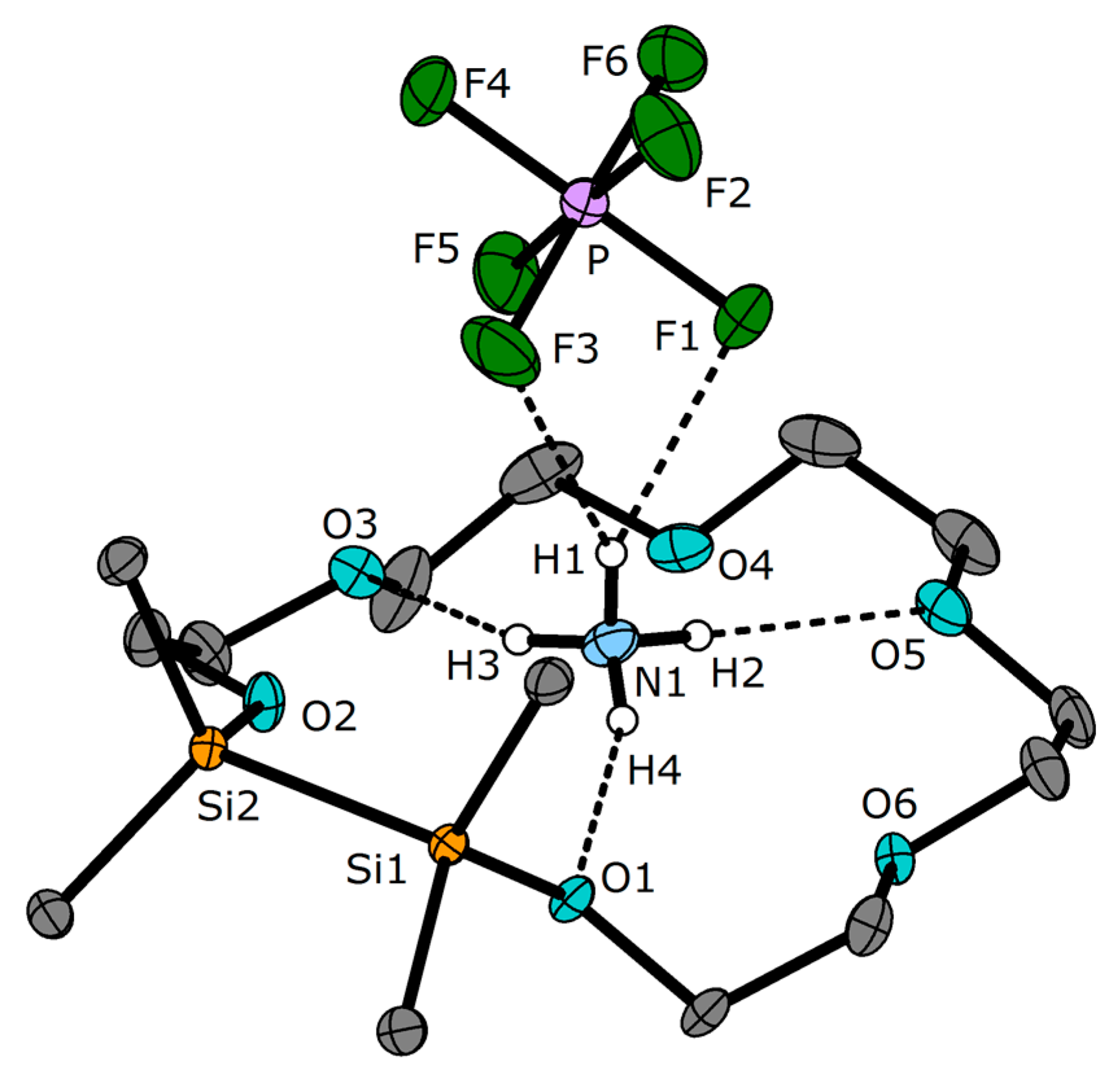
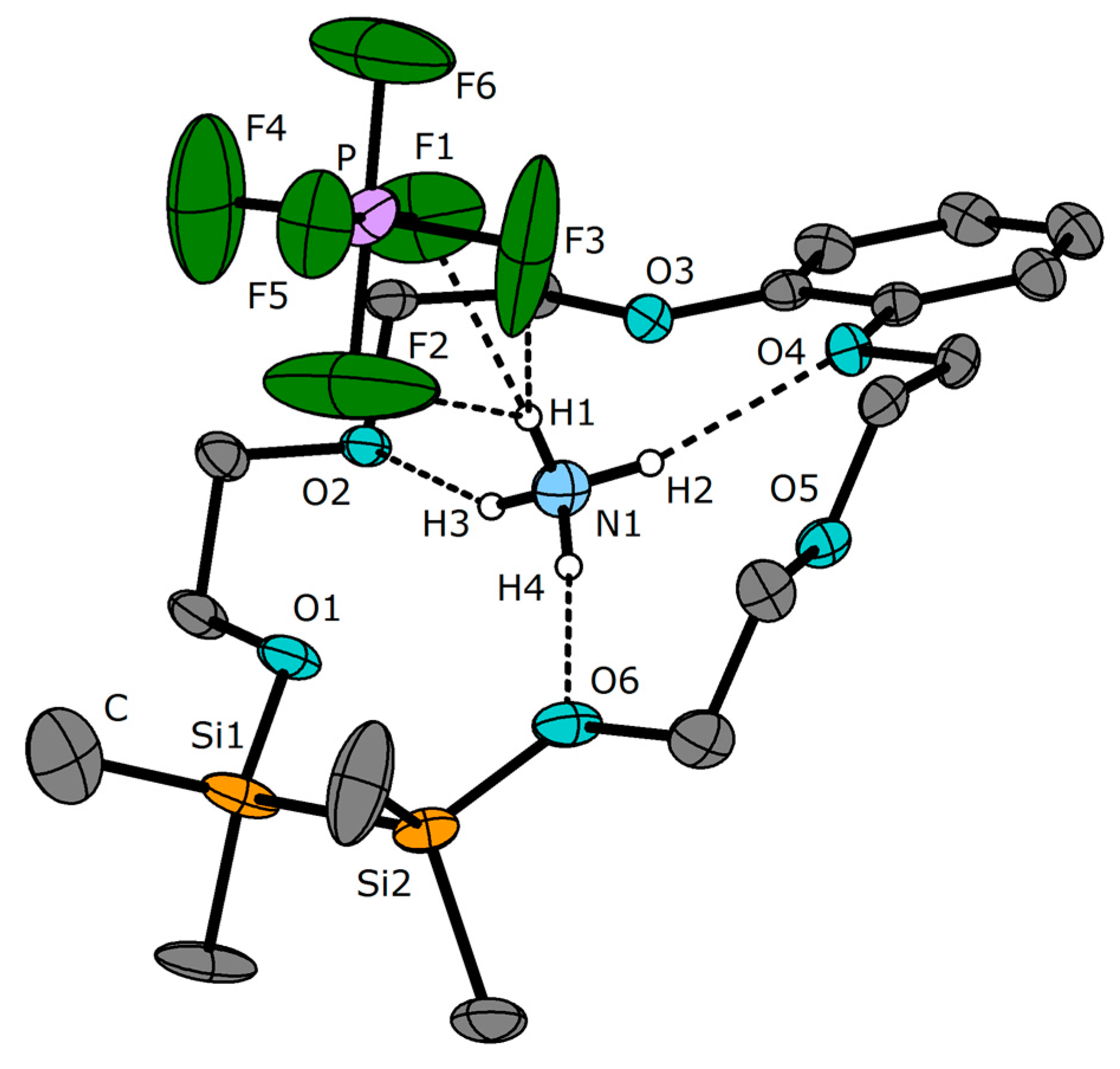
| Compound or CSD Refcode 1 | D–H 2 | A | d [pm] | T 3 | ω [°] | ϕ [°] | Ref. 4 |
|---|---|---|---|---|---|---|---|
| 3 | N–H2 | O5 | 206 | CE | 160 | 113 | * |
| N–H3 | O3 | 203 | CE | 156 | 108 | * | |
| N–H4 | O1 | 205 | C | 159 | 122 | * | |
| 4 | N–H2 | O4 | 214 | CE | 165 | 117 | * |
| N–H3 | O2 | 209 | CE | 151 | 110 | * | |
| N–H4 | O6 | 200 | C | 172 | 118 | * | |
| VONMOB | N–H | O | 226 | C | 174 | 128 | [38] |
| MEQFOD | N–H | O | 247 | C | 141 | 131 | [39] |
| ITUBUI | N–H | O | 198–210 | C | 157–160 | 130–132 | [40] |
| MOLYUO | O–H | O | 192 | Si | 167 | 116 | [23] |
| TAKFOB | O–H | O | 257–260 | Si | 148–152 | 139–148 | [41] |
| ZEMXAQ | O–H | O | 199 | Si | 156 | 116 | [42] |
| EGEKAC | O–H | O | 199–200 | C | 155–161 | 114–115 | [43] |
| PERWIS | O–H | O | 199 | C | 166 | 123 | [44] |
| REXXAT | O–H | O | 199 | C | 173 | 111 | [45] |
| 3 | 4∙DCM | |
|---|---|---|
| Empirical formula | C14H36F6NO6PSi2 | C19H38Cl2F6NO6PSi2 |
| Formula weight [g·mol−1] | 515.59 | 648.55 |
| Crystal colour, shape | colourless block | colourless rod |
| Crystal size [mm] | 0.487 × 0.432 × 0.346 | 0.076 × 0.106 × 0.522 |
| Crystal system | monoclinic | monoclinic |
| Space group | P21 | Cc |
| Formula units | 2 | 4 |
| Temperature [K] | 100(2) | 100(2) |
| Unit cell dimensions [Å, °] | a = 10.4542(5) | a = 14.9582(7) |
| b = 12.3869(6) | b = 12.6454(6) | |
| c = 10.6140(5) | c = 16.3325(8) | |
| β = 117.912(1) | β = 104.950(2) | |
| Cell volume [Å3] | 1214.57(10) | 2984.8(2) |
| ρ calc [g/cm3] | 1.410 | 1.443 |
| μ [mm−1] | 0.286 | 0.422 |
| 2θ range [°] | 4.342 to 50.568 | 4.280 to 53.570 |
| Reflections measured | 34532 | 68974 |
| Independent reflections | 4419 | 6355 |
| R1 (I > 2σ(I)) | 0.0203 | 0.0535 |
| wR2 (all data) | 0.0529 | 0.1329 |
| GooF | 1.076 | 1.035 |
| Largest diff. peak/hole [e∙Å−3] | 0.24/−0.27 | 0.51/−0.44 |
| Flack parameter | 0.004(14) | 0.048(16) |
© 2018 by the authors. Licensee MDPI, Basel, Switzerland. This article is an open access article distributed under the terms and conditions of the Creative Commons Attribution (CC BY) license (http://creativecommons.org/licenses/by/4.0/).
Share and Cite
Dankert, F.; Reuter, K.; Donsbach, C.; Von Hänisch, C. Hybrid Disila-Crown Ethers as Hosts for Ammonium Cations: The O–Si–Si–O Linkage as an Acceptor for Hydrogen Bonding. Inorganics 2018, 6, 15. https://doi.org/10.3390/inorganics6010015
Dankert F, Reuter K, Donsbach C, Von Hänisch C. Hybrid Disila-Crown Ethers as Hosts for Ammonium Cations: The O–Si–Si–O Linkage as an Acceptor for Hydrogen Bonding. Inorganics. 2018; 6(1):15. https://doi.org/10.3390/inorganics6010015
Chicago/Turabian StyleDankert, Fabian, Kirsten Reuter, Carsten Donsbach, and Carsten Von Hänisch. 2018. "Hybrid Disila-Crown Ethers as Hosts for Ammonium Cations: The O–Si–Si–O Linkage as an Acceptor for Hydrogen Bonding" Inorganics 6, no. 1: 15. https://doi.org/10.3390/inorganics6010015



